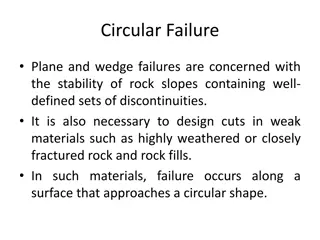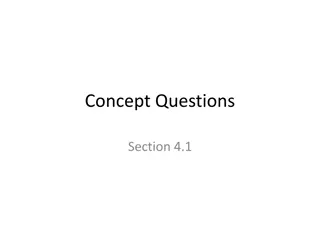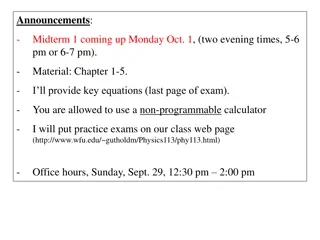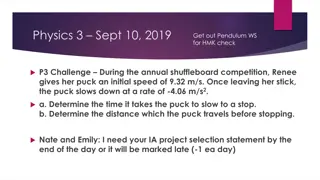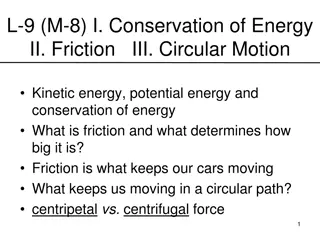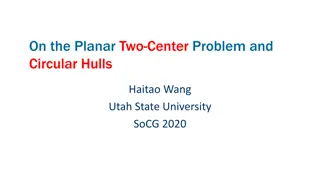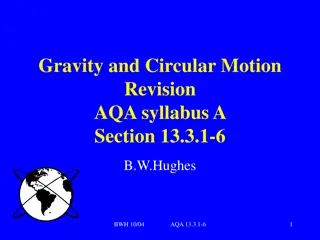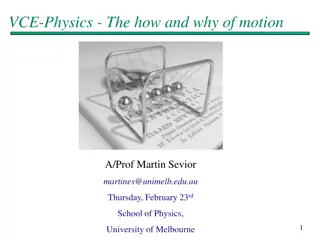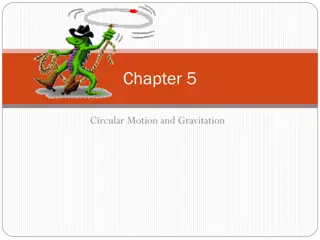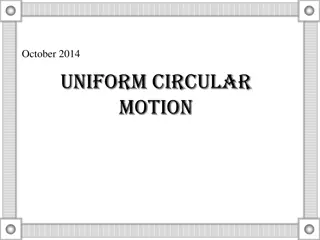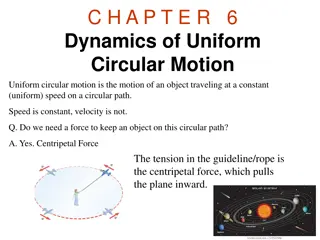Understanding Circular Motion Concepts in Physics
Explore the fundamentals of uniform circular motion, centripetal acceleration, and tangential velocity with real-world examples. Learn how to calculate velocities and accelerations in circular motion scenarios, and understand the difference between tangential speed and velocity in rotating systems. Dive into practical applications and equations to deepen your knowledge of circular motion principles.
Download Presentation

Please find below an Image/Link to download the presentation.
The content on the website is provided AS IS for your information and personal use only. It may not be sold, licensed, or shared on other websites without obtaining consent from the author. Download presentation by click this link. If you encounter any issues during the download, it is possible that the publisher has removed the file from their server.
E N D
Presentation Transcript
Uniform Circular Motion October 2014
Circular Motion A is towards the center. V is tangential to the motion Speed is constant, V changes A force directed towards the center is what causes the acceleration (e.g. gravity, a string) If the force is removed, the ball will continue in a straight line at the speed it had.
Check your understanding When a wheel rotates about a fixed axis, do all the points on the wheel have the same tangential speed? Yes! Do they all have the same velocity? No! How do you know?
Check your understanding How do you know?
Circular Motion Equations Vt= 2 r/T ac = vt2/r Where Vt = tangental velocity R = radius T = period (time required to make one complete circle) Ac = centripetal acceleration
Circular Motion We do The radius of a spacecraft orbiting earth is 6.67 x 106 m. If it orbits earth in 5292 seconds, what is the velocity of the spacecraft? Vt= 2 r/T = 2* *6.67X106m / 5292 sec = 7919 m/s
Circular Motion We do Jimmie Johnson is driving his #48 Lowe s NASCAR around a bend that has a radius of 70 meters. It takes him 30 seconds to travel the track. What was the centripetal acceleration of Jimmie John s #48 Lowe s NASCAR? Strategy: find vt, then find ac. Vt= 2 r/T= 2 *70m/30sec = 14.66m/s ac = vt2/r = (14.66 m/s)2 / 70 m = 3 m/s2
Centripetal Acceleration You do a. A girl sits on a tire that is attached to an overhanging tree limb by a rope. The girl s father pushes her so that her centripetal acceleration is 3.0 m/s2. If the length of the rope is 2.1 m, what is the girl s tangential speed? b. A boy swings a yo-yo horizontally above his head so that the yo-yo has a centripetal acceleration of 1.5m/s2. If the yo-yo s tangential speed is 11m/s, what is the length of the yo-yo? c. Correct the following statement: The racing car rounds the turn at a constant velocity of 145 km/h.
Quadratic Equation Quadratic equations, such as x = vit + a t2 can be tricky to solve. 3 strategies 1. Factoring (doesn t usually work well with physics) 2. Quadratic Equation solution (always works, but you need to memorize) 3. Trial & Error / Plugging in values (can be useful for multiple choice) We will talk about #2 and #3.
Quadratic Equation Solution First, put your equation into this form: 0 = at2 + bt + c for example, x = vit + at2 becomes 0 = at2 +vit x so , a = a b = vi c = -x Then, use this equation to solve for t
Quadratic Equation Solution We do A ball is launched upward with a speed of 15 m/s from an intial height of 5 m. What are the two approximate times that the object will be located at the height of 10 m above the ground?
Quadratic Equation Solution We do A ball is launched upward with a speed of 15 m/s from an intial height of 5 m. What are the two approximate times that the object will be located at the height of 10 m above the ground? 0 = at2 +vit x so , a = a = * - 9.8 m/s2 = -4.9 m/s b = vi = 15 m/s c = -x = -10 m tt = 0.5 sec and 1 sec
Plugging in Numbers Sometimes, you can just plug in numbers into the equation to find the solution. Works best with multiple choice.
Plugging in Numbers Sometimes, you can just plug in numbers into the equation to find the solution. Works best with multiple choice. Example WE DO A car and truck start from the same position. The car has a constant velocity of 20 m/s. The truck has an initial velocity of zero, but accelerates 3 m/s. At approximately what time does the truck overtake the car? A. 6.6 s B. 10.2 s C. 13.4 s D. 15.1 S
Plugging in Numbers Sometimes, you can just plug in numbers into the equation to find the solution. Works best with multiple choice. Example WE DO A car and truck start from the same position. The car has a constant velocity of 20 m/s. The truck has an initial velocity of zero, but accelerates 3 m/s. At approximately what time does the truck overtake the car? A. 6.6 s B. 10.2 s C. 13.4 s D. 15.1 S Use x = vit + at2 for each car and compare x. At which answer choice does the truck final reach the car?
Plugging in Numbers Sometimes, you can just plug in numbers into the equation to find the solution. Works best with multiple choice. Example WE DO A car and truck start from the same position. The car has a constant velocity of 20 m/s. The truck has an initial velocity of zero, but accelerates 3 m/s. At approximately what time does the truck overtake the car? A. 6.6 s B. 10.2 s C. 13.4 s D. 15.1 S Use x = vit + at2 for each car and compare x. At which answer choice does the truck final reach the car?
Quadratic Equation You do A ball is dropped from 15 ft. At what time will the ball be 5 ft from the ground? Car 1 and Car 2 start at the same position. Car 1 has an initial velocity of 10 m/s and an acceleration of 5 m/s2. Car 2 has an initial velocity of 15 m/s and an acceleration of 2 m/s2. At one time will car 2 overtake car one? A. 1.2 sec B. 2.5s C. 3.4 s D. 4.2 s
Exit ticket & Homework Exit ticket: write facts about circular motion Homework: Circular acceleration problems Review problems Extra credit: Write 3 challenging physics problems and solve them on another sheet of paper. Upcoming: CFA Wed / Thur next week. Exam right after break.






